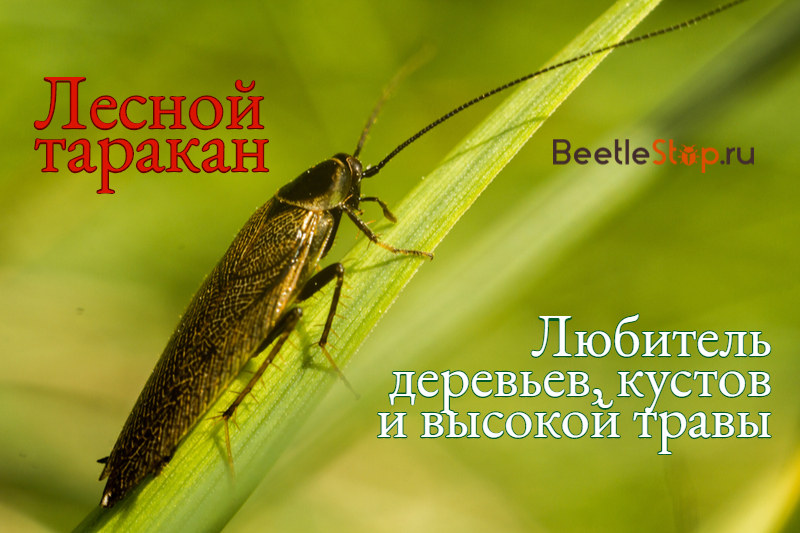Forest cockroach - a cute inhabitant of forest litter
In nature, more than 4,500 species of cockroaches are found. Some of them are synanthropic, live in close connection with a person. Others, like a forest cockroach, prefer to run freely in the litter of leaves. Insects love heat and moisture, but at the same time easily adapt to difficult living conditions. About their stamina says the opportunity to live a month without a head.

Description of related species
Forest cockroach (Ectobiussylvestris) is a typical representative of the cockroach squad, family Ectobiidae. This is the largest group of 2,400 species. The genus Ectobius or forest cockroaches combined several similar species. Among the characteristic features of the anatomical structure of insects:
- antenna length exceeds body size;
- cerci (a pair of appendages on the last segment of the abdomen) are articulated;
- the hips of the hind legs are covered with spikes;
- there are no hairs on the body.
Some species of insects of the genus Ectobius that live in Eurasia are difficult to distinguish from each other. Among them:
- Steppe cockroach - size 7 mm, body color grayish-yellow with a black stripe on the pronotum. In males, the elytra reach the church; in females, they are shortened. The wintering stage is the egg. Larvae appear in May; by July they turn into adults.
- Lapland cockroach - body length 10-14 mm, elytra grayish-yellow or brown, black spot on pronotum with blurry contours. The species lives in the forest part of Europe, comes across in the tundra and forest-steppe. Elytra in females of normal length, under them there are functioning wings. Larvae overwinter. Insects feed on organic debris, dry leaves.
Forest cockroach morphology
Adult Ectobiussylvestris is only 7-10 mm long. The color of insects is yellowish brown, less often grayish. On the pronotum there is a large black spot with well-defined borders. The body is oval, flat. The head is triangular, with complex faceted eyes located on the sides. Antennas or antennae elongated, bristle-shaped. They serve as the organs of smell. The mouth apparatus is gnawing. Chitin teeth are located on strong jaws.
Elytra leathery, with obvious venation, transparent thin wings hiding under them. Males use them for flights from branch to branch. A female forest cockroach has short elytra, which cover a small part of the abdomen. The wings are also reduced. Females cannot fly. The insect has three pairs of running legs. The front ones are shorter than the rest. The hips of the hind and middle legs are covered with rows of spikes. The abdomen consists of 10 segments.
Distribution area
Forest cockroach is found throughout Europe, with the exception of the British Isles. The northern border of the habitat passes through Finland and Sweden. Insects are common in Asia and the Middle East. The species was artificially brought to North America and Canada, where it took root perfectly.
Lifestyle & Reproduction
Forest cockroach fully lives up to its name, the insect spends all its life in forest litter. Active males spend time crawling through bushes, tree branches or tall grass. In the afternoon they can be seen flying from branch to branch. Females are slow, prefer to crawl under fallen leaves or moss. The diet of insects is exclusively plant food.They eat decayed hornbeam and oak leaves, lichens growing on tree trunks.
Adults are found in the warm season - from May to September. Mating occurs in late spring. Fertilized females lay a capsule with eggs in a secluded place - in the crevices of the bark, under the leaves. In the ooteca, eggs are protected from various negative factors. Cockroaches insects with incomplete conversion. After the embryo phase, a larva follows, then an imago.
In June, offspring hatch. Larvae are smaller copies of adult insects, just do not have wings. They also like compost feed on adults. With the onset of cold weather, diapause sets in. Small forest cockroaches dig deeper into the litter and fall into a stupor until spring. Raising the temperature to positive levels serves as a signal for awakening. In May, overwintered larvae transform into adults, ready to begin a new life cycle.
Related view from the tropics
A close relative of a forest cockroach lives in the tropical jungle of South America. The lifestyle of insects is quite similar, but the sizes are different. The tropical species is called Blaberusgigantes, its length reaches 10 cm. A giant insect lives in the lower tier of the forest. It feeds on the organic remains of plants, does not disdain to eat corpses of animals. Cream insects with black stripes on the elytra and pronotum. The giant forest cockroach has large wings. Males use them not only for flights, but during courtship for females. Large insects are often kept at home as pets.

